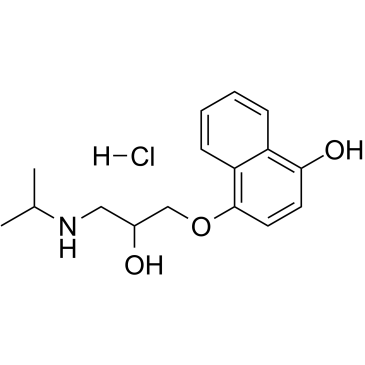Potent antioxidant properties of 4-hydroxyl-propranolol.
I Tong Mak, William B Weglicki
Index: J. Pharmacol. Exp. Ther. 308(1) , 85-90, (2004)
Full Text: HTML
Abstract
The antioxidant properties of 4-HO-propranolol (4HOP), a major metabolite of propranolol, were studied and compared with that of propranolol and vitamin E (Trolox). When isolated hepatic microsomal membranes were peroxidized by an iron-catalyzed.OH-generating system [dihydroxyfumarate +Fe (III)], 4HOP potently and concentration-dependently inhibited lipid peroxidation; the IC50 value was 1.1 microM, whereas those for Trolox and propranolol were 4.3 and 168 microM, respectively. When isolated human low-density lipoprotein (LDL) was oxidized by 7.5 microM Cu(II) for 9 h, 4HOP at 3 microM delayed the lag phase significantly by 108 min, which was comparable with that of probucol (98-min delay) but was far greater than that provided by propranolol (6 min) or Trolox (47 min). At 1 microM 4HOP, the delay was 45 min. When confluent cultured bovine aortic endothelial cells were exposed to the Fe-catalyzed oxy-radical system, acute loss of glutathione occurred (55% decrease in 50 min). Pretreatment of the cells with 0.067 to 6.7 microM 4HOP for 30 min provided increasing degrees of protection against the glutathione loss; the EC50 value was 1.2 microM, whereas those for Trolox and propranolol were 7.9 and 49 microM, respectively. The loss of cell survival due to the radical stress was also effectively preserved by 4HOP. In separate experiments, when the endothelial glutathione was oxidatively depleted by a peroxynitrite-generating system (3-morpholinosydnonimine), 4HOP also provided potent protective activities. In conclusion, 4HOP is 4- to 8-fold more potent than vitamin E and >100-fold more active than propranolol as a "chain-breaking" antiperoxidatant against membrane and LDL oxidation and can provide superior endothelial cytoprotective efficacy against oxygen- or nitrogen-derived oxidant-mediated cell injury. Being a major metabolite in human and with its plasma level approaching that of propranolol, 4-HO-propranolol may contribute, in part, to the cardiovascular therapeutic benefits of propranolol.
Related Compounds
| Structure | Name/CAS No. | Molecular Formula | Articles |
|---|---|---|---|
 |
4-hydroxy propranolol hcl
CAS:14133-90-5 |
C16H22ClNO3 |
|
Stereoselective high-performance liquid chromatography deter...
1997-04-25 [J. Chromatogr. B. Biomed. Sci. Appl. 692(1) , 133-40, (1997)] |
|
Potential bias and mitigations when using stable isotope lab...
2010-01-01 [J. Chromatogr. B. Analyt. Technol. Biomed. Life Sci. 878(31) , 3267-76, (2010)] |
|
Hep G2 cell line as a human model for sulphate conjugation o...
1992-08-01 [Xenobiotica 22(8) , 973-82, (1992)] |
|
Involvement of SULT1A3 in elevated sulfation of 4-hydroxypro...
2005-03-15 [Biochem. Pharmacol. 69(6) , 941-50, (2005)] |
|
Immunoaffinity isolation of the sulfate conjugate of 4'-hydr...
[J. Chromatogr. A. 612(2) , 320-5, (1993)] |